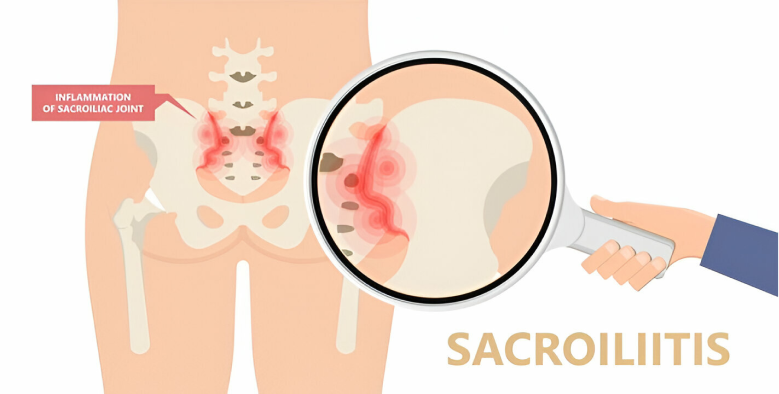
Sacroiliac Joint Dysfunction Treatment & Doctors in Bangalore
- Home
- Conditions
- Back & Spine Conditions
- Sacroiliac Joint Dysfunction
There are many different terms for sacroiliac joint problems, including SI joint dysfunction, sacroiliac joint disease, SI joint syndrome, SI joint strain, and SI joint inflammation. Each of these terms refers to a condition that causes pain in the SI joints from a specific cause.
As with most other joints in the body, the SI joints have a cartilage layer covering the bone. The cartilage allows for some movement and acts as a shock absorber between the bones. When this cartilage is damaged or worn away, the bones begin to rub on each other, and degenerative arthritis (osteoarthritis) occurs. This is the most common cause of SI joint dysfunction. Degenerative arthritis occurs commonly in the SI joints, just like other weight-bearing joints of the body.
Another common cause of SI joint dysfunction is pregnancy. During pregnancy, hormones are released in the woman’s body that allow ligaments to relax. This prepares the body for childbirth. Relaxation of the ligaments holding the SI joints together allows for increased motion in the joints and can lead to increased stresses and abnormal wear. The additional weight and walking pattern (altered gait) associated with pregnancy also places additional stress on the SI joints.

Common SI Joint Pain Symptoms
- Lower back pain (below L5)
- Sensation in lower extremity: pain, numbness, tingling, weakness
- Pelvis/buttock pain
- Hip/groin pain
- Feeling of leg instability (buckling, giving way)
- Disturbed sleep patterns due to pain
- Disturbed sitting patterns (unable to sit for long periods, sitting on one side)
- Pain going from sitting to standing
SIGNS
- Compression test
- Distraction test
- Patrick Test
- Fortwin finger test
- Thigh Thrust test
- Gaenslen test
- Gillet test
Causes of SI Joint Pain
SI joint injury is mainly caused by a combination of axial loading and rotational forces. For instance twisting while carrying a heavy object
Trauma and degeneration are the two main causes of SI joint dysfunction and pain.
What Causes SI Joint Pain?
- Sacroiliac (SI) joint dysfunction and associated pain can be caused by a specific traumatic event (disruption) or can develop over time (degeneration). Sacroiliac Trauma (common events that may cause SI joint disruption)
- Motor vehicle accident
- Fall on buttock
- Lifting and/or twisting
- Natural childbirth
- Pregnancy (chronic low back pain during and/or after pregnancy is frequently referred to pelvic girdle pain)
- Sacroiliac Joint Degeneration (common causes)
- Previous lumbar spine surgery (e.g., fusion of the lumbar vertebrae)
- Stresses to the SI joint due to leg length differences, joint replacement, or scoliosis
- Osteoarthritis
- Previous iliac crest bone graft (ICBG)
- Prior infection of the SI joint
- Ankylosing spondylitis and Rheumatoid arthritis
- Paget’s disease
- Joint infections
- Osteitis Condensans Ili
DIAGNOSIS
The diagnosis in SI joint pain is a tricky proposition as at most times no single imaging modality like x ray, CT and MRI correlate satisfactorily with the clinical picture.
MRI is generally resorted to rule out red flag signs and other disorders of the lower back.
The gold standard in diagnosis is still a LA injected into the joint and pain relief is noted.
THE IASP Criteria
- Pain present in the region of the PSIS
- Clinical tests stressing the SIJ reproducing pain
- Selectively infiltrating the putative joint with local anaesthetic complete resolves the pain
TREATMENT
Generally, these treatments can be divided into 2 categories: those directed at correcting the underlining pathology and those aimed at alleviating symptoms. To optimize outcomes, the identification and treatment of concomitant psychosocial issues is of paramount importance. This is best accomplished via a multidisciplinary approach.
Conservative Management The non-interventional management of SI joint pain should ideally address the underlining pathology. In patients with true or apparent leg length discrepancy, this might include the use of shoe inserts to more equitably distribute the load borne by the SI joints. Because leg length discrepancies are frequently found in asymptomatic individuals (37) and many patients already compensate for their lower extremity length difference by altering their gait or posture, most experts recommend starting out cautiously with inserts that correct only half the incongruity. For SI joint pain resulting from altered gait mechanics and spine malalignment, physical therapy and osteopathic or chiropractic manipulation have been reported to reduce pain and improve mobility.
Intraarticular Injections
Intraarticular injections with steroid and LA often serve the dual function of being therapeutic and aiding in diagnosis. To summarize these studies, most but not all investigators have found radiologically guided SI joint injections to provide good to excellent pain relief lasting from 6 mo to 1 yr .

Proliferative therapy
Prolotherapy- has been advocated as a treatment for nonspecific LBP and SI joint pain The rationale behind the use of “prolotherapy” is that the ligaments and other soft tissue structures are of primary importance in the development of LBP. Thus, the injection of a drug promoting fibroblast hyperplasia should theoretically increase the strength and reduce sensitization of these structures
Radiofrequency Denervation Procedures
Several investigators have performed radiofrequency (RF) denervation procedures in an attempt to provide prolonged pain relief to patients suffering SI joint pain. The techniques used have ranged from denervating the nerves supplying the SI joint ) to creating lesions in the joint itself , with one study using a combination of the two. The success rates of studies targeting the nerve supply are higher than those focusing on the joint itself, with approximately two thirds of patients reporting significant pain relief.
Surgery
Fusion surgery is considered when all conservative measures fail
PREVENTION
- Pelvic floor exercises/ Kiegel’s exercises after pregnancy
- Avoid becoming overweight
- Some form of physical exercise to mobilises and strengthen spine
- Improved understanding of this highly misdiagnosed condition by doctors
Treatment for Sacroiliac Joint Dysfunction
At Alleviate
we specialize in treating sacroiliac joint dysfunction, a common source of lower back and buttock pain. Our comprehensive approach combines advanced medical interventions with physiotherapy and lifestyle modifications to alleviate symptoms and enhance your quality of life.
Medical Interventions
- Intra-Articular Injections
- Steroid Injections: Reduce inflammation and pain in the sacroiliac joint.
- PRP (Platelet-Rich Plasma) Therapy: Stimulate healing and tissue repair for long-term relief.
- Prolotherapy: Strengthen ligaments and stabilize the joint to improve function.
Comprehensive Care
- Physiotherapy: Tailored programs to improve joint mobility, strengthen surrounding muscles, and optimize posture.
- Lifestyle Modifications: Guidance on ergonomic adjustments, activity modifications, and self-care techniques to manage symptoms effectively.
Why Choose Us?
- Integrated Treatment Approach: Incorporating state-of-the-art therapies with personalized physiotherapy and practical lifestyle strategies.
- Expertise and Experience: Led by skilled specialists with extensive experience in sacroiliac joint dysfunction management.
- Patient-Centered: Committed to enhancing your comfort, mobility, and overall well-being with individualized treatment plans.
Video Spotlight
Blog
Surgery-Free Solutions
Expert Tips for Pain Management
Testimonials
Words From Our Patients
I went to the clinic after I had severe tingling and pain in both my legs all the way till my toes. I was treated by Dr. Faraz, who checked my MRI and my back and told me that my pain was because of my vertebrae as well as a problem in my SI or pelvic joint. So he suggested spinal pain injections to reduce the pain. The doctor was well spoken and had a good bedside manner. However the spinal injections had very less effect on my pain. But the medications prescribed were a lot more effective. Then i was told to undergo physiotherapy. Dr Sumalatha was always very polite and knowledgeable. She treated me with ultrasound and electric therapy. She would also suggest exercises that did help improve my pain. My pain is down by 50 percent. But it's not gone completely. I hope the change is permanent and it doesn't revert back.
I am 47 years old, had an injury to the hip long ago. Because of that trauma, I started developing knee joint pain. I had come across Alleviate Pain Management Indiranagar through a friend and approached them. I met Dr.Faraz Ahmed and was very much convinced with his treatment. He is very friendly and a good listener. He understood my problem and started 3 PRP treatments. I have finished my course of treatment and undoubtedly there is improvement. The staff is very cordial and cooperative.
I had consulted Dr Swagatesh Bastia for my mom’s hip pain. The doctor was patient enough to listen to all the challenges what she faced. This I found as a good quality since in majority of the cases, doctors are always in a hurry without even ready to be attentive listeners to the patients who come with illnesses. The doctor was also not in a rush to diagnose something at the overview level and prescribe medicines and treatments rather went into a detailed diagnosis. Based on his suggestion the Physiotherapy sessions also helped my mom to feel better. All the physiotherapists who did the sessions for mom were professional, emphathetic and considerate about what my mom was going through and dealt with her accordingly. Overall happy with the consultation and the Physio sessions undertaken at Alleviate Pain Management Clinic Dasarahalli.







